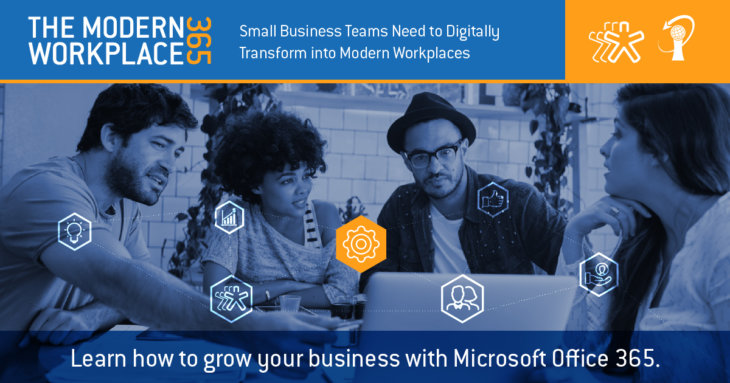Today’s tech-centric world has profoundly changed the way we work, play, communicate, buy, and sell. This isn’t the world of The Jetsons with its flying cars and robot maids; this is a place where technology is an integral part of your business and the way your teams sell to, market to, and support your customers.
This is why Nimble is teaming up with Microsoft to help business teams work better, smarter, and faster in the modern workplace.
 “In the Modern Workplace, businesses aren’t just using technology — they are being transformed by it.
“In the Modern Workplace, businesses aren’t just using technology — they are being transformed by it.
“Artificial Intelligence (AI), integrated with digital marketing, enables you to not only develop new leads, but to use sales intelligence to score and rank those leads by level of engagement, potential value, and their likelihood to close.”
– Gavriella Schuster Corporate VP, Microsoft One Commercial Partner Organization
Cloud-native applications deliver cutting-edge applications in less time, with less up-front investment, and with less technology infrastructure than ever before.
CRM software tools integrate with the social, collaboration, and desktop tools your team and your customers use every day, providing a single source of customer information so that customer-facing teams all have access to the same information whenever they need it.
Maybe most importantly, digital business means providing your teams with the modern sales, marketing, and workplace tools they need to collaborate and make informed decisions, giving your business a competitive advantage.
The unprecedented rate of technology innovation is all but guaranteed to disrupt small business models (as well as cultures and economies across the world) for years to come.
The Modern Workplace enables you to be more competitive, to respond more quickly to market and customer opportunities, and to run your business more efficiently and effectively.
Understanding, anticipating, and adapting to these changes will significantly impact your ability to compete and thrive.
The Modern Workplace 365 is a five-part series designed to help small business teams and lean startups understand the megatrends reshaping customer and employee experiences.
The series will share the benefits, challenges, and opportunities of digital transformation; and the priorities to consider when charting your digital business strategy.
On behalf of Nimble and the International Association of Microsoft Channel Partners (IAMCP), we applaud your success and are deeply honored to join Microsoft, channel partners and ISVs who have become an important part of this journey.
What is Digital Business?
Digital business enables SMBs to extend or transform your business model, using technology either as an enabling tool, or as an integral part of the product or service itself.
Technology is no longer something that your company simply “uses;” instead, technology has become an integral part of your product, service, and organization. It’s embedded in your business so you can focus on human-to-human engagements.
 “If we can offload all of the computational day-to-day things, enabling us to reclaim time and focus on creativity and relationship building, then we can do what humans are good at while relying on our software, devices, and even our office environment to optimize our ability to do our jobs well.”
“If we can offload all of the computational day-to-day things, enabling us to reclaim time and focus on creativity and relationship building, then we can do what humans are good at while relying on our software, devices, and even our office environment to optimize our ability to do our jobs well.”
– Alan Lepofsky, Vice President and Principal Analyst, Constellation Research
Emerging Digital Business Opportunities
Placing Conversation at the Center of Customer Relationships
Digital business can create new opportunities and competitive advantages for your company. Customer relationship management (CRM) and social networking enable more effective prospecting and conversational selling, enabling teams to reach out to customers and prospective buyers using their preferred communication channels in a context that is meaningful to them.
Artificial intelligence (AI) can score leads to help sales teams identify high-probability, high-value leads, and can also automate the internal processes your team has developed to help manage those leads effectively.
Customer data and insight can be stored in a single tool where anyone that has responsibility for interfacing with the customer (including sales, marketing, support, or even the finance department) can access and use that data to make better-informed decisions.
Nimble, for example, provides a CRM solution that meets the needs of small business teams, particularly those adopting their first CRM system, and enables those companies to create a repository for all customer support data.
Its unified source of enriched contact records ensures business teams can easily reach, inform, and engage prospects and customers at scale using personalized, customer-centric communications, which is a clear competitive advantage. Digital sales data, conversational interactions from email and social sites, and interactions from calls and meetings can all be accessed by any employee that needs that information.
Nimble also integrates contacts from Outlook and Office 365, social media, and more than 140 SaaS applications, which can be critical when a company has multiple team members engaging with customers and prospective buyers across different departments, channels, and siloed business applications.
Nimble’s 80% end-user adoption rates attest to the immediate value small business teams realize when fixing deep-rooted contact information management software issues.


– Oliver Deng, Founder & CEO of headhuntr.io, a 50-person tech company that’s growing at triple-digit rates by revolutionizing the recruitment industry.
Whereas Microsoft Dynamics 365 is an ideal CRM/ERP solution for groups of 200+ people, Nimble is widely recommended for small business teams looking to fill the gap between Office 365 and Dynamics. Migrating to Cloud-Based Solutions Saves Time and Costs While Adding Reliability, Flexibility
Cloud-native applications can be deployed much more quickly than on-premise applications, increasing productivity while reducing the IT overhead required to implement and support those applications. Cloud licensing models, which are subscription-based, reduce what used to be large up-front investments in software and servers.
This helps to align technology cost with technology ROI.
When selecting Office 365, G Suite, or another productivity suite as the cornerstone of the digital workplace, most businesses weigh employees’ desire to continue using their preferred desktop productivity applications; ensuring files are stored securely in the cloud; and ensuring that access to email is easy, flexible and easily scalable.


“I, of course, love Microsoft. Our reseller network has enabled tens of thousands of small businesses to build Office 365-based digital workplaces, get a clear view of customers and empower employees to solve their needs.”
– Stacy Nethercoat, VP of Tech Data Cloud Solutions Americas
Cloud Service Providers can help assess your current environment, prioritize your goals so as not to over-engineer your solution, and (based on your risk tolerance and desired timeframe) enable your optimal migration path.
How to Empower a Digitally Savvy Workforce
Most successful businesses recognize that your employees are your company’s most valued asset. Digitally savvy teams need collaborative, cross-functional workspaces and business insights to do their jobs effectively.



I’m excited that we’re starting to see a little bit of a shift from customer-centricity to employee-centricity. That’s the key.”
– Alan Lepofsky, Vice President and Principal Analyst, Constellation Research
Business is more competitive than ever, and digital business has changed the rules of the game even more. Your competitors are embracing these tools; you can either use them to gain a competitive advantage, or you can fall behind.


– David Gersten, Practice Manager: Dynamic Consulting
Modern Workplace Challenges for Small Business
The single biggest technology challenge facing small businesses today is dealing with the pace of change.
There is continuous innovation in all areas of technology; a typical SMB is challenged with knowing which of their possible technology options are a priority, and with understanding how their options can plug and play easily (or not) with each other.
Some integrations have already been done for you; for example, between a cloud-based CRM application like Nimble and personal productivity applications like Microsoft Office 365.
On the other hand, an integration between a cloud application with a modern architecture and older, on-premise, or “legacy” applications you already have in your company, may be more challenging. It is important to map out your technology infrastructure and identify potential challenges integrating with mission-critical applications.


“I’ll bring in some of my more technical resources across the company and have them participate in doing some side research and figure out if the path of that technology is something that we want take a look at. Now that we’re on Office 365 and Dynamics 365 for sales, it’s just integrated right in there. It’s much easier for us to work with. My sales team, of course, they’re working directly with it right through the interface and so they’re high-touch and high-activity.”
– Jay Manley, President, Mekorma. The company’s flagship product, Mekorma Payment Hub, is the best-selling check printing and EFT security enhancement for Microsoft Dynamics GP.
Finally, there is the challenge of changing and adapting internal processes that will enable you to realize the benefit of digital business. It is not enough to just automate your existing ways of doing things; “paving the cow paths” doesn’t work. The competitive advantage of digital business and a digital workplace requires investments in people and process, as well as in technology.
Encourage your teams to be part of the re-evaluation of current processes, and work with them to identify ways to use digital business technology to streamline your customer interactions.
Three Things You Need to Know About the Modern Workplace
Most organizations recognize the value and the need for digital business and for making their customer-facing employees more efficient. At the same time, there is often some resistance to change and uncertainty due to the multiple technology options that need to be evaluated.


“So is your workplace modern? Digital? That depends on where you live.
“The reality is that today’s ‘modern’ workplace in America is still in its infancy. We know what it can be. We actually see it in action. But the majority of businesses in this country are still a ways off from getting there.”
– Gene Marks, Columnist, Speaker And President, The Marks Group PC
Here are three things to consider as you begin your own company’s digital business journey:
1. It’s not a matter of “if,” it’s a matter of when – and how.
Not embracing digital business and a customer-centric approach to your business is no longer an option. Begin implementing this change today to better understand your options.
2. Technology is not enough.
Digital business requires investment in technology, people, and processes while rethinking both your customer’s experience and the modern workplace you need to provide for your teams.
3. Focus on employees in your digital business plans to power their work.
Employees today are technologically literate and multi-generational; the tools they use need to support their culture, cross-functional collaboration, and use-model.



